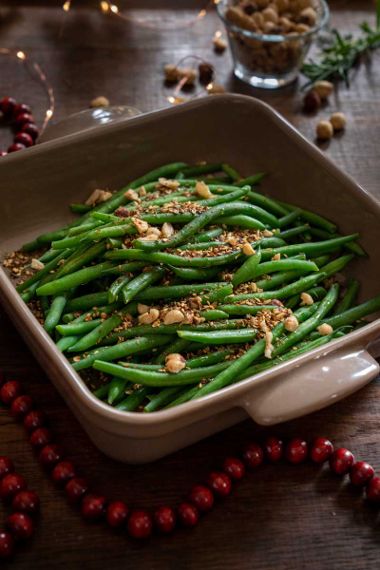A Plant-Based Holiday Meal
It’s time for a holiday feast! With “festive” officially allowed back in our vocabularies, you’re not alone if you’re looking forward to a more celebratory holiday this year. While you’re busy being grateful for more (Zoom-less) time with family or enjoying some mulled wine with friends, why not also highlight the joys that elegant meat-free meals can bring?
If you’re thinking the holidays just wouldn’t be the same without your family’s traditional turkey, roast, or ham, these wow-worthy plant-based recipes won’t disappoint. They might just become a new tradition––whether you skip the meat entirely or incorporate some of the dishes into your celebratory meal.
From a seasonal persimmon salad that’ll make you fall in love with the sweet fruit to a crunchy-on-the-outside, soft-on-the-inside, gluten-free vegan stuffing (cooked outside the bird), to an airy pear mousse that reaches skyward with aquafaba instead of egg whites, this plant-based holiday menu looks beyond processed meat replacements. A Mediterranean touch peeks in with an antipasti platter of roasted vegetables. And the pièce de résistance? Tantalizing balsamic-glazed oyster mushrooms on a bed of rich-tasting (but surprisingly light!) caramelized parsnip purée. How sweet it is to be together.

Puréeing ripe persimmons into a creamy dressing makes for a sweet and juicy salad without excess oil. Persimmons are a seasonal treat with a local heritage. Native to the southeastern US and Asia, but able to be grown in Canada, and now grown around the world, much of what’s available in this country comes from California, Spain, and South Africa and starts appearing in markets in late fall and early winter.

In this plant-based stuffing, fresh herbs and dried fruit replace the depth of flavour usually infused by chicken juices, so use fresh thyme and rosemary if possible to maximize the flavour return. By baking the stuffing in a shallow dish, the bottom stays wonderfully soft and moist while the top becomes addictively crunchy, as opposed to an in-bird stuffing that ends up monotonously mushy.

Subbing Middle Eastern dukkah for classic toasted almonds with your green beans is like taking your first international trip (or the first in a long time …) and (re)discovering that there’s a world of flavour out there. Dukkah is a blend of toasted nuts and spices that varies from region to region and home to home, so feel free to substitute pistachios (which you might already have for the glazed oyster mushrooms and caramelized parsnips), almonds, peanuts, Brazil nuts, walnuts, or sunflower seeds for some or all of the hazelnuts, and play with the type and amount of seeds. Dukkah also makes for a crunchy, nutty addition to the persimmon salad. You probably won’t mind that this recipe makes a little extra.

This dish is a plant-based showstopper, with tender mushrooms in a sweet-and-sour glaze soaking into ultra-thick roasted parsnip purée. The parsnip is extra savoury and sweet thanks to a quick dunk in a pot with baking soda, whose alkaline nature makes for a stronger Maillard reaction, a.k.a. more caramelization when the parsnips are roasted.

Wait, isn’t mousse all about egg whites? Turns out, aquafaba––the viscous liquid left over after cooking chickpeas––fluffs up pretty well, too. And no, it doesn’t make the mousse taste like chickpeas. Plus, you don’t need to worry about using unpasteurized eggs, and it’s vegan-friendly. To reduce the sugar content, skip the praline and simply toast the pecans.
Have a localvore holiday feast!
Here are a few ways to go a little further for the environment and support local this season.
Keep it local
Hit up farmers’ markets, organic stores, co-ops, and your own garden for all the fixings for your holiday dinner. Root vegetables such as parsnips are great local bets; like pears, they keep well for months after harvesting. And even if the weather outside is frightful, herbs such as mint and chives, microgreens, and green onions can survive indoors and in pots near sunny windows, even if they’re not as productive as in summer.
Save for a rainy day
Freeze any leftovers you won’t eat quickly. While these recipes most likely produce many leftovers (you might want to make a double batch of the oyster mushrooms), everything except the persimmon salad can be frozen––even the mousse! So, if it’s looking like you won’t get to those beans, stuffing, or roasted vegetables within four days, stick them in airtight, serving-size or family-size containers to freeze for later. They’ll keep safely frozen indefinitely, but will lose flavour and moisture after about four months.
Return to earth
Compost your food scraps and outdated leftovers. Caring about your environmental footprint doesn’t stop at what you put into your body, so make sure you have a green way of disposing of anything you can’t use. Better yet, keep the bottoms of your green onions and stick them in a glass of water, making sure the bottom of the bulb and all the roots are immersed but with some of the top exposed, and refreshing the water every few days. They’ll sprout and give you endless green onion tops. Plus, in spring, you can transplant the bulb outside!
Buy organic legumes
Nonorganic beans, lentils, oats, bran, nuts, and peas are permitted to be grown with certain amounts of glyphosate, a chemical that’s been linked to cancer. This past summer, Canada’s Pest Management Regulatory Agency proposed an increase in the amount of glyphosate permitted in Canadian food. It was revealed in July that Bayer, the owner of Monsanto, made the initial request.
After public backlash, the government paused proposed glyphosate increases in August, but we’re not out of the woods yet. What can you do? Email the Ministry of Health and Prime Minister Trudeau to let them know that an increase isn’t in Canadians’ best interests. And support organizations including Vigilance OGM (in French: vigilanceogm.org) and Safe Food Matters (in English: safefoodmatters.org), which also list appropriate email addresses and necessary information.






